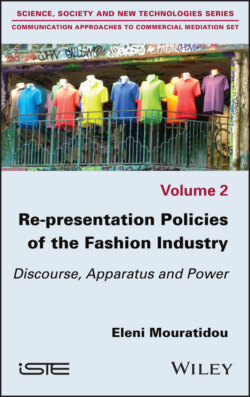Читать книгу Re-presentation Policies of the Fashion Industry - Eleni Mouratidou - Страница 19
I.8.3. Corpus (texts, objects, practices)
ОглавлениеThe corpus analyzed was composed of heterogeneous but complementary data, resulting from the communication strategies of brands and groups in the fashion industry. The communication strategies here included any practice, any object or any text – advertising campaign, ready-to-wear collection, museum exhibition – likely to produce mediation. These practices, texts and objects were selected according to two criteria established upstream and without spatiotemporal delimitation32. The first was that of the segment: advertisers specializing in commercial luxury ready-to-wear33. The second is that of borrowing and rewriting: the aim was to work on objects, practices and texts that witness a rewriting and an enunciative depth that explicitly or implicitly cites the fields of art, culture, religion, the sacred and politics. Some data from the specialized press were also introduced into the corpus, since they seemed to present the same communicational aim as that observed in the communicational strategies of advertisers in the fashion industry. The corpus was therefore the result of syncretic materials, such as ready-to-wear and leather goods collections, photographs from advertising campaigns, photographs taken during visits, guided or not, to museum exhibitions offered by advertisers in the sector as well as to places where the heritage of a luxury fashion brand was promoted, but also observations and photographs taken in commercial spaces (boutiques, department stores).
All of these strategies and practices were also illustrated and even discussed using discursive material from all kinds of press articles, selected according to their thematic relevance. I would like to point out that this material hardly constituted a closed corpus, subjected to systematic analysis and did not allow a representative account of the media’s position and media coverage from which the fashion industry’s re-presentational policies benefitted. On the one hand, its use was illustrative. On the other hand, it provided an overview of the place that certain advertisers occupy in the media space, including in national or regional daily press titles for which fashion is not a preferred subject. Finally, the consultation of press articles also made it possible to study, I would remind you, in an illustrative and not representative way, a possible “discursive smoothing of the forms of diversity and heterogeneity in general” (Oger and Ollivier-Yaniv 2006, author’s translation) likely to harm the image of advertisers in the sector studied.
This research was partly organized around a process of direct observation, implemented in the context of exhibitions offered by fashion brands or department stores and on the occasion of the opening of certain ateliers or group headquarters at special events. These exhibitions were visited as part of a research approach, with the aim of observing the discourses and scenographies offered throughout their visit. To put it another way, this attendance was not motivated, at least not solely, by a personal interest in fashion, but by the desire to seize the device deployed in order to enable retail advertisers to reconsider themselves and their products. From a methodological point of view, this practice of observation, which is both direct and participatory, was in line with the issues pointed out by Fontanille (2006, pp. 13–14), who notes that “the semiotic practice itself has largely exceeded textual limits, by taking an interest, for more than twenty years, in architecture, urban planning, object design, market strategies, cigar or wine tasting, and more generally in the construction of a semiotics of situations” (Fontanille, 2006, pp. 13–14, author’s translation). What I therefore call a corpus is more generally a set of heterogeneous materials, of varying levels of relevance, ranging from signs to texts, including formats, practices, situations and even strategies.
